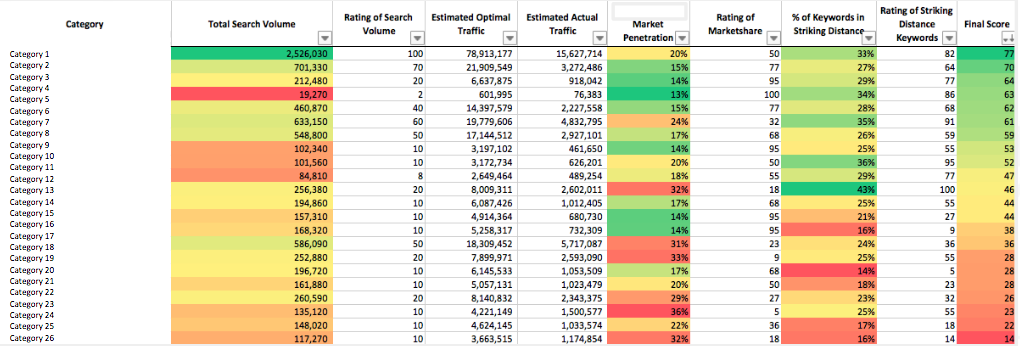This is part 1 of 5 posts on how integrated teams can build killer assets for your eComm website.
Part 1: Prioritization Part 2: Audience Interviews Part 3: Design & Creation Part 4: Paid Social Part 5: Organic Promotion
-----
Choosing a category from a million possibilities for your digital asset is more than enough to drive us crazy. But it doesn’t have to be!
Follow these six steps to making sure you’re choosing a category that’s inspired by data, has high success potential, and most importantly is in line with your whole team’s goals.
- Step 1: Determine your goal
- Step 2: Confirm goal with all stakeholders
- Step 3: Pull metrics that correspond with your goals
- Step 4: Categorize your URLs
- Step 5: Create a scorecard for all categories aggregate URLs
- Step 6: Discuss potential categories as a team and select a category
Keep in mind, there is no one correct way to approach the prioritization dilemma. These steps might work for your site perfectly. They might need to be tweaked based on the way your site or business is set up. And you might have a better way. If you do, please let us know in the comments below!
Step 1: Determine your goals
First and foremost: Determine. Your. Goals.
For our purposes on the SEO team, these goals are usually one of the following:
- Rankings
- Traffic
- Conversions
- Revenue
- All of the above
Starting with a goal provides a structure and north star throughout the asset process, one that typically involves a lot of people. In other words, it can be used as a decision maker down the line. An asset idea can be really awesome in every way, but if it doesn’t tie back to your goal, you shouldn’t move forward with it.
Our recommendation is to tie your goals back to revenue as closely as possible. This allows you to look back on the performance of your asset later and assign it a specific ROI.
Step 2: Confirm goal with all stakeholders
Aligning on goals is arguably the most important step of the whole asset process
If the whole team isn’t aligned on goals, your asset is at risk to be shut down before it’s even out of the gate. (Or worse ... right before it’s scheduled to launch!)
For this process, we’re defining a stakeholder as anyone who will be involved with this asset and/or has the power to veto the project down the line
Step 3: Pull metrics that correspond with your goals
We recommend pulling as many metrics as possible for your current category URLs. However, you should put extra emphasis on metrics that correspond with your goals
For example:
- If the main goal for your asset is revenue, focus on conversion rate, organic revenue and/or margin, etc.
- If the main goal for your asset is traffic, focus on historical traffic, search volume, etc.
Step 4: Categorize your URLs
Depending on your URL structure, this can be simple. Or it can be terrible.
If the URL structure you’re working with isn’t easy to decipher, my advice is to work with someone on your content or analytics team.
When we worked on Staples' Chair Buying Guide, Zain hooked us up with their content manager who had a cheat sheet of each URL ID and what that means for what supercategory, category, and department that URL lived in.
Step 5: Create a scorecard for all categories aggregate URLs
Now that you’ve got all this data, you can aggregate it and create a scorecard of all the different metrics you care about.
I’m going to show an example of a scorecard we put together for Staples to show the opportunity that existed across their supercategories.
One thing to call out is that if one metric is much more important to your goal than others, the beauty of the scorecard is that you can weight metrics as heavily as you want. For example, you can weight search volume as a 1 because demand is important but then you can weight margin and conversion rate as a 2x or 3x because revenue is that much more important.

We looked at total search volume for an aggregate of all the keywords that belonged to each category. Then we assigned each category a score based on that high-low. This can be as simple as a 1-26 score, or you can give it a weighted score.
We also looked at optimal traffic which was calculated using an estimated position 1 CTR multiplied by search volume. Then we estimated actual traffic, which used the estimated actual ranking position CTR multiplied by search volume. Then putting actual over optimal, we got the estimated market penetration of that category. In other words, how much of the market is there for the taking. Are we already saturating it? Or is it a blue ocean?
Next we looked at striking distance keywords. How much low-hanging fruit is available to us in a category vs. a category where it would be a huge uphill battle to see the first page wins?
Bonus Tip: This can provide a lot of insights to a whole organization. We recommend sharing this scorecard with as many product line owners as possible. Even if their product doesn’t get picked, it can still shed some light on opportunity and performance.
Step Six: Discuss potential categories as a team and select a category
Once you’ve got your list of prioritized topics, make sure to return to your stakeholder group.
You never know when an asset is already in the works or maybe a product you think is a good opportunity is actually going to be discontinued in the near future.
Plus, whoever works on that product you pick will be a huge asset (no pun intended) to you throughout this process. It’s important to make sure they are on board before you start asking for content reviews and SME advice. I still owe a few people at Staples like ... a lot of chocolate, or beer, for the number of content reviews we asked for.
So you’ve got your topic! Go forth!


